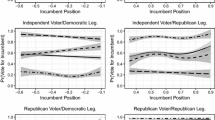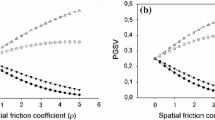Abstract
Competing spatial models of voter choiceare compared in the context ofparliamentary representatives selectedthrough single-member district, pluralityelections where party platforms areemphasized over individual candidates.Respondents of the 1987, 1992, and 1997British general election surveys ratepolitical parties on a series of issuescales. Ordered logistic regressions ofparty evaluations under proximity,directional, and mixed models reveal thatthe classic spatial model and thedirectional model perform equally well.Differences center on perceptions of thestatus quo, as voters appear to evaluatethe incumbent party (here, theConservatives) slightly differently thanminority parties (Labour and the LiberalDemocrats). The proximity model worksbetter for voter evaluations of governingparties while the directional model workswell for opposition parties.
Similar content being viewed by others
References
Adams, J. (1999). An assessment of voting systems under the proximity and directional models of the vote. Public Choice 98: 131-151.
Black, D. (1958). The theory of committees and elections. New York: Cambridge University Press.
Davis, O.A., Hinich, M.J. and Ordeshook, P.C. (1970). An expository development of a mathematical model of the electoral process. American Political Science Review 64: 426-448.
Dow, J.K. (1998). Directional and proximity models of voter choice in recent U.S. Presidential elections. Public Choice 96: 259-270.
Downs, A. (1957). An economic theory of democracy. New York: Harper&Row.
Endersby, J.W. and Galatas, S.E. (1998). British parties and spatial competition: Dimensions of party evaluation in the 1992 election. Public Choice 97: 363-382.
Enelow, J.M., Endersby, J.W. and Munger, M.C. (1993). A revised probabilistic spatial model of elections: Theory and evidence. In B. Grofman (Ed.), Information, participation and choice: An economic theory of democracy in perspective. Ann Arbor: University of Michigan Press.
Enelow, J.M. and Hinich, M.J. (1984). The spatial theory of voting. New York: Cambridge University Press.
Gilljam, M. (1997). The directional theory of voting under the magnifying glass. Journal of Theoretical Politics 9: 5-12.
Grofman, B. (1985). The neglected role of the status quo in models of issue voting. Journal of Politics 47: 230-237.
Heath, A., Jowell, R. and Curtice, J.K. (1987). British general election survey 1987 [computer file], ICPSR version. London: Social and Community Planning Research [producer], 1992.Ann Arbor, MI: Inter-university Consortium for Political and Social Research, 1996.
Heath, A., Jowell, R., Curtice, J.K., Brand, J.A. and Mitchell, J.C. (1993). British general election survey 1992 [computer file], ICPSR version. London: Social and Community Planning Research [producer], 1992. Colchester: ESRC Data Archive/Ann Arbor: Interuniversity Consortium for Political and Social Research, 1996.
Heath, A., Jowell, R., Curtice, J.K. and Norris, P. (1998). British general election survey 1997 [computer file], ICPSR version. London: Social and Community Planning Research [producer], 1998. Colchester: ESRC Data Archive/Ann Arbor: Inter-university Consortium for Political and Social Research, 1996.
Hinich, M.J. and Munger, M.C. (1997). Analytical politics. Cambridge: Cambridge University Press.
Iverson, T. (1994). Political leadership and representation in Western European democracies: A test of three models of voting. American Political Science Review 38: 45-74.
Lewis, J.B. and King, G. (2000). No evidence on directional vs. proximity voting. Political Analysis 8: 21-33.
Macdonald, S.E., Listhaug, O. and Rabinowitz, G. (1991). Issues and party support in multiparty systems. American Political Science Review 85: 1107-1131.
Macdonald, S.E., Rabinowitz, G. and Listhaug, O. (1998). On attempting to rehabilitate the proximity model: Sometimes the patient just can't be helped. Journal of Politics 60: 635-690.
Macdonald, S.E., Rabinowitz, G. and Listhaug, O. (2001). Sophistry versus science: On further efforts to rehabilitate the proximity model. Journal of Politics 63: 482-500.
Merrill, S., III. (1995). Discriminating between directional and proximity spatial models of electoral competition. Electoral Studies 14: 273-287.
Merrill, S., III, and Grofman, B. (1997). Directional and proximity models of voter utility and choice: A new synthesis and an illustrative test of competing models. Journal of Theoretical Politics 9: 25-48.
Merrill, S., III, and Grofman, B. (1999). A unified theory of voting: Directional and proximity spatial models. Cambridge: Cambridge University Press.
Pierce, R. (1997). Directional versus proximity models: Verisimilitude as the criterion. Journal of Theoretical Politics 9: 31-74.
Rabinowitz, G., and Macdonald, S.E. (1989). A directional theory of issue voting. American Political Science Review 83: 93-121.
Westholm, A. (1997). Distance versus direction: The illusory defeat of the proximity theory of electoral choice. American Political Science Review 91: 865-883.
Westholm, A. (2001). On the return of epicycles: Some crossroads in spatial modeling revisited. Journal of Politics 63: 436-481.
Author information
Authors and Affiliations
Rights and permissions
About this article
Cite this article
Cho, S., Endersby, J.W. Issues, the Spatial Theory of Voting, and British General Elections: A Comparison of Proximity and Directional Models. Public Choice 114, 275–293 (2003). https://doi.org/10.1023/A:1022616323373
Issue Date:
DOI: https://doi.org/10.1023/A:1022616323373




